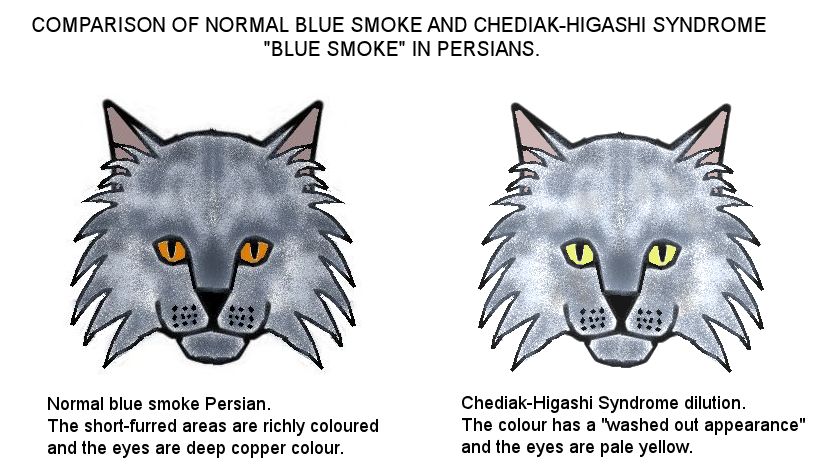
A Blue Smoke Persian and a Chediak-Higashi Smoke Persian
CHEDIAK-HIGASHI SYNDROME DILUTION IN PERSIAN CATS
CHEDIAK-HIGASHI SYNDROME (CHS) DILUTION (CHEDIAK-HIGASHI SMOKE)
This has only been found in Persians and manifested as blue smoke fur with yellow to light-green eyes (normal blue smoke Persians have darker fur and orange/copper eyes). Their eyes reflected red and tended to be sensitive to light. The cats developed cataracts as early as 3 months old. Melanin pigment granules in all tissues, not just the fur, were abnormally in size and shape due to combining with abnormally large lysosomes (part of a cell's digestion mechanism). CHS cats tend to develop kidney lesions, and have impaired vision due to the abnormal pigmentation in the retina. The University of Sydney, Australia's Faculty of Veterinary Science defines CHS as a "rare, lethal disorder" but it better meets the criteria for an "impairing mutation" as its effects can be mitigated with proper care. Affected cats are highly susceptible to infection, due to the abnormally large lysosome in their white blood cells. Bacterial infections occur repeatedly because the white blood cells cannot respond normally to infection; antibiotic treatment is required to combat infection. Prolonged bleeding tends to occur because of abnormal blood platelets delaying clotting. In the laboratory, CHS cats had a longer period of eye-flicker, compared to non-CHS Persians, after being spun around.

A Blue Smoke Persian and a Chediak-Higashi Smoke Persian
Despite the many side effects, cats given appropriate care can have a good quality of life. Because it affects health, the trait should not be deliberately propagated as a colour curiosity. For those with a scientific background, here are several references and abstracts about the condition.
Collier LL, King EJ, Prieur DJ. Aberrant melanosome development in the retinal pigmented epithelium of cats with Chediak-Higashi syndrome. Exp Eye Res. 1985 Sep;41(3):305-11. "Chediak-Higashi syndrome is a genetic disorder characterized by greatly enlarged cytoplasmic granules, including lysosomes and melanosomes. Eyes of humans and animals with Chediak-Higashi syndrome are hypopigmented to various degrees. Intraocular melanin granules vary in size, with some being massively enlarged. Electron microscopic examination of retinal pigmented epithelium of kittens with Chediak-Higashi syndrome disclosed a number of abnormalities of premelanosomes and melanosomes. Few premelanosomes were present. Most of the melanin granules were giant sized, but their structures varied. Some of the giant granules were composed of several premelanosomes and melanosomes in different stages of maturation. Others contained randomly oriented melanofilaments between melanosomes. There were also complex giant granules consisting of both melanosomal and lysosomal components. Inappropriate fusion of cytoplasmic granules appears to be the most likely mechanism for formation of the giant granules. Fusion of premelanosomes with lysosomes and resultant destruction of the premelanosomes probably is a major cause of the ocular hypopigmentation of Chediak-Higashi syndrome."
Hargis AM, Prieur DJ. Animal model: renal lesions in cats with Chediak-Higashi-Steinbrinck syndrome. Am J Med Genet. 1987 Jan;26(1):169-79. "In this study designed to characterize the renal lesions in cats with the autosomal recessive Chediak-Higashi-Steinbrinck syndrome (CHS), the renal tubular epithelial cells of CHS cats were examined by light microscopy. The lesions observed were similar to those in the renal epithelial cells of other species with CHS and were consistent with those reported previously in other tissues of CHS cats."
Kramer JW, Davis WC, Prieur DJ. The Chediak-Higashi syndrome of cats. Lab Invest. 1977 May;36(5):554-62. "Three cats with Chediak-Higashi syndrome were found in a single line of 27 Persian cats, and three additional affected cats were produced from two prospective breedings of the original line. The disorder was characterized genetically as an autosomal recessive condition. All cats in the line with the combination of yellow eye color and "blue smoke" hair color exhibited the disorder. Four of the five cats examined had bilateral nuclear cataracts as early in life as 3 months of age. No increased susceptibility to infectious disease was observed. A bleeding tendency was noted. Light microscopic studies of hair and skin revealed enlarged melanin granules. These manifestations were similar to those in man, mink, cattle, mice, and the killer whale with Chediak-Higashi syndrome. Cats are the sixth species in which this genetic disease has been reported." [Note: later studies of CHS cats found the immune system to be impaired]
Prieur DJ, Collier LL. Morphologic basis of inherited coat-color dilutions of cats. J Hered. 1981 May-Jun;72(3):178-82. "The melanin granules in hair of black, smoke, blue, Chediak-Higashi-smoke, and pink-eyed dilution cats were studied. The hair of black cats contains numerous small dark brown to black melanin granules uniformly distributed throughout all portions. The basis for the dilution in smoke cats is a paucity of melanin granules in the basal portions of the hair. Blue cat hair has a larger basic melanin granule, some very large but relatively regularly shaped granules, and a non-uniform distribution of granules. The granules in the blue cat hair resemble those in the hair of dilute mice. The Chediak-Higashi trait causes even larger basic melanin granules than the blue dilution and enlarged and relatively irregularly shaped granules. The melanin granules in the hair of the pink-eyed dilution cat are very small, and are yellowish brown compared to the dark brown to black of those of black, moke, and blue cats."
Prieur DJ, Collier LL. Inheritance of the Chediak-Higashi syndrome in cats. J Hered. 1981 May-Jun;72(3):175-7. "The phenotypes with respect to the Chediak-Higashi syndrome (CHS) of 245 cats from 67 matings were analyzed. It was determined that the gene for feline CHS, like that in other species with CHS, is inherited in an autosomal recessive manner with complete penetrance. We propose the symbol ch for the gene for CHS in cats. "